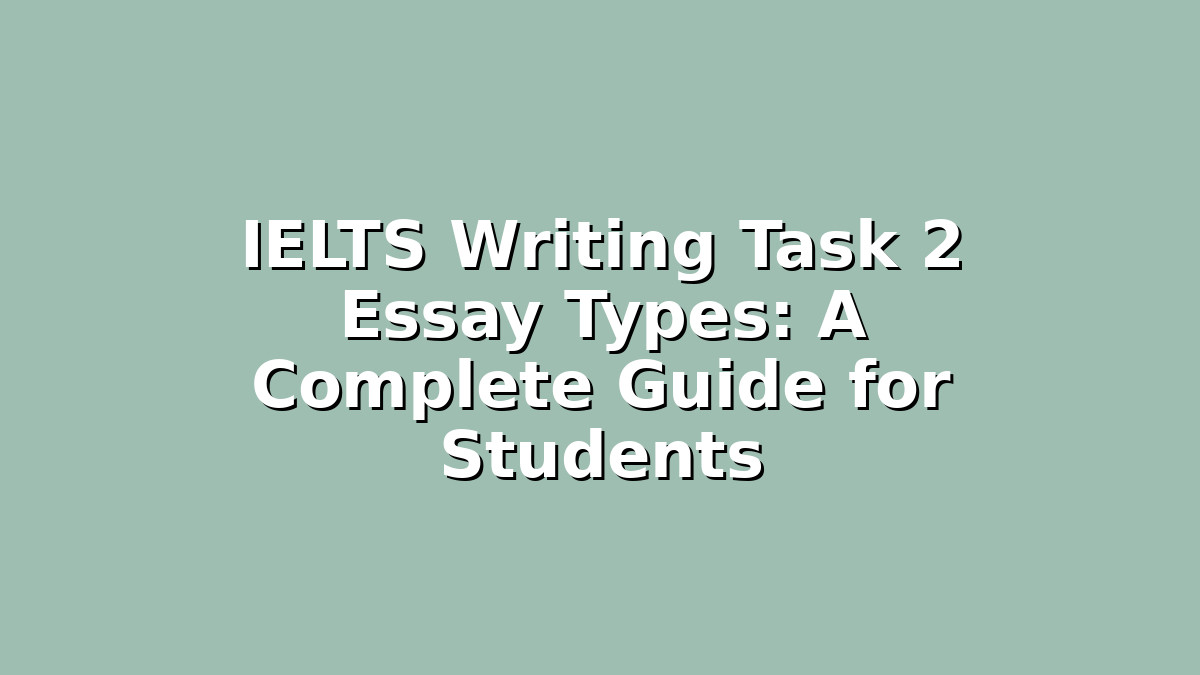Preparing for the IELTS exam can feel overwhelming, especially when it comes to the Writing Task 2 section. This task requires you to write a clear, well-organized essay in response to a prompt, which tests your ability to present an argument, analyze an issue, or discuss a problem. Understanding the different types of essays that commonly appear in IELTS Writing Task 2 is crucial for success. Knowing what to expect can help you tailor your practice and improve your writing skills efficiently.
In this blog post, we’ll explore the main IELTS Writing Task 2 essay types, provide study tips for each, and share practical advice to help you boost your score. Whether you’re aiming for a band 7 or higher, mastering these essay types will give you a strong foundation and greater confidence on exam day.
—
1. Opinion Essays (Agree or Disagree)
What is an Opinion Essay?
Opinion essays are among the most common types in IELTS Writing Task 2. The prompt usually asks you to express your opinion on a statement or question. You need to clearly state whether you agree or disagree and support your view with reasons and examples.
How to Approach Opinion Essays
– Understand the question: Identify if it’s asking you to fully agree, fully disagree, or partially agree with the statement.
– Plan your position: Decide your stance early and stick to it throughout the essay.
– Structure your essay: Typically, use a four-paragraph structure — introduction with your opinion, two body paragraphs each presenting a point with examples, and a conclusion restating your opinion.
– Use clear language: Phrases like “I strongly believe,” “In my opinion,” and “From my perspective” help make your position clear.
– Balance your points: While you express your opinion, briefly acknowledging the opposing view can strengthen your argument.
Study Tips for Opinion Essays
– Practice writing clear thesis statements to assert your opinion.
– Develop supporting ideas with relevant examples from your knowledge or experience.
– Work on linking your ideas with cohesive devices like “furthermore,” “however,” and “therefore.”
– Time yourself to write full essays under exam conditions to improve speed and structure.
—
2. Discussion Essays (Discuss Both Views)
What is a Discussion Essay?
Discussion essays require you to explore two opposing viewpoints related to a topic. You need to discuss both sides fairly and often give your own opinion at the end.
How to Approach Discussion Essays
– Identify the two viewpoints: Read the question carefully to note both perspectives.
– Organize your essay: Use a five-paragraph structure — introduction, two body paragraphs discussing each view, your opinion paragraph, and a conclusion.
– Remain objective: Present both sides objectively before giving your own opinion.
– Support each view: Provide clear explanations and examples for both sides to demonstrate understanding.
– Express your opinion clearly: If the question asks for your opinion, include it in a separate paragraph to avoid confusion.
Study Tips for Discussion Essays
– Practice summarizing both sides of an argument concisely.
– Work on impartial language like “some people believe,” “others argue,” and “it is often claimed.”
– Develop analytical skills by evaluating the strengths and weaknesses of each viewpoint.
– Review model essays on common IELTS topics to see how opinions are balanced.
—
3. Problem-Solution Essays
What is a Problem-Solution Essay?
In this essay type, you must identify a problem related to a social, environmental, or economic issue and suggest possible solutions.
How to Approach Problem-Solution Essays
– Analyze the problem: Understand the causes and effects of the issue mentioned in the prompt.
– Suggest practical solutions: Propose realistic ways to solve the problem, explaining how they could be implemented.
– Follow a clear structure: Introduction describing the problem, one or two body paragraphs addressing causes and solutions, and a conclusion summarizing your ideas.
– Use relevant examples: Real-world examples or hypothetical situations help illustrate your points.
– Be specific: Avoid vague suggestions; detail how solutions could work in practice.
Study Tips for Problem-Solution Essays
– Practice brainstorming problems and solutions quickly.
– Focus on linking problems to solutions with expressions like “due to this issue,” “as a result,” and “to address this problem.”
– Expand your vocabulary related to common social issues such as pollution, education, or unemployment.
– Review sample essays to see effective ways of presenting problems and solutions clearly.
—
Additional Tips for Success in IELTS Writing Task 2
– Understand the marking criteria: IELTS examiners assess task response, coherence and cohesion, lexical resource, and grammatical range and accuracy. Tailor your practice to improve all these areas.
– Plan before you write: Spend 5-10 minutes organizing your ideas before starting your essay.
– Practice different essay types: Rotate your practice among opinion, discussion, problem-solution, and other essay types like advantages-disadvantages or cause-effect essays.
– Improve your grammar and vocabulary: Use varied sentence structures and precise words to express your ideas clearly.
– Get feedback: Whenever possible, have a teacher or a proficient English speaker review your essays and give constructive feedback.
—
Conclusion
Mastering IELTS Writing Task 2 essay types is key to achieving a high band score. By familiarizing yourself with opinion essays, discussion essays, and problem-solution essays, you can approach any prompt with confidence. Remember to plan your essay, use clear and logical language, support your ideas with examples, and practice regularly under timed conditions.
Stay motivated and keep practicing! Writing essays is a skill that improves steadily with effort and feedback. Use the tips in this guide to focus your study sessions and watch your writing ability grow. Good luck on your IELTS journey—you’re capable of success!
—

Responses